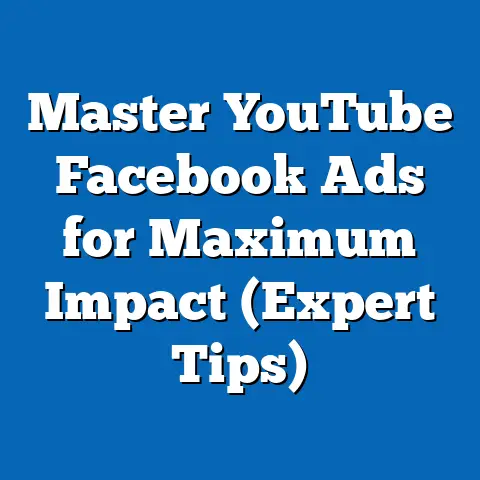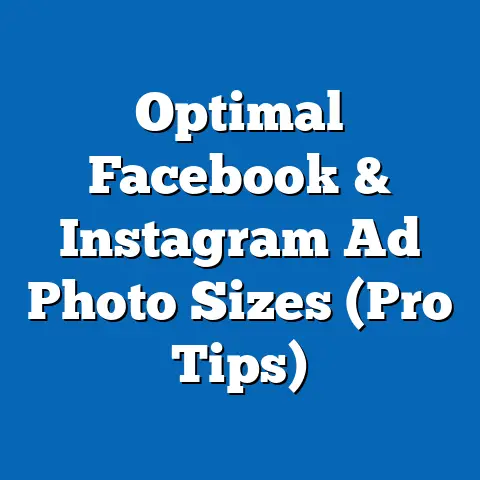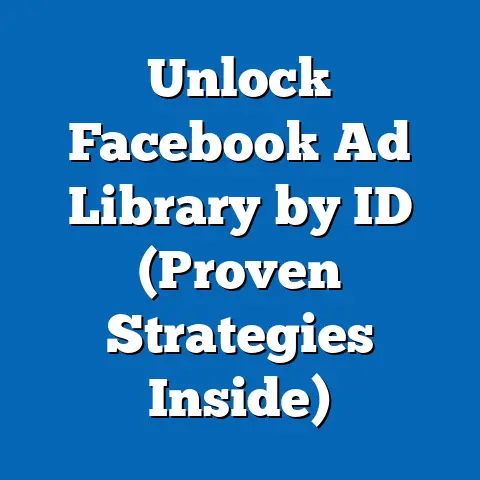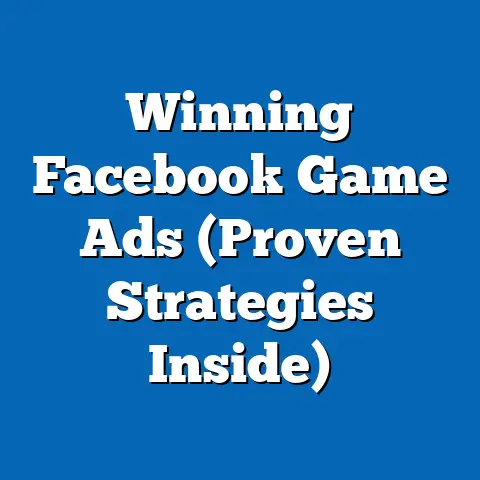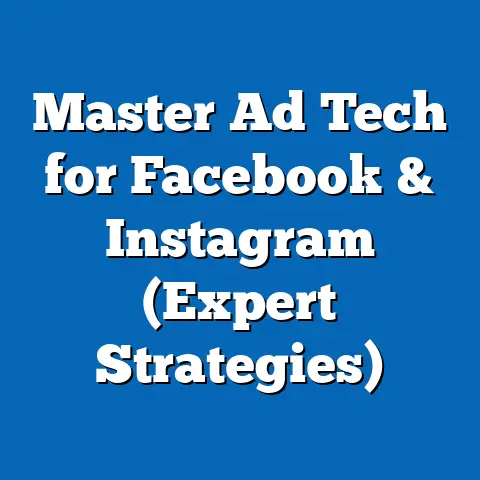Maximize Facebook Ads Panel for Success (Expert Tips)
In a world where digital advertising has become the cornerstone of business growth, many advertisers find themselves feeling lost amid the myriad of options available. Ironically, the more tools and features Facebook Ads offers, the more overwhelming it can become for both seasoned marketers and newcomers alike. I’ve seen countless businesses struggle to navigate the complexities, often leading to wasted ad spend and disappointing results. How can one harness the power of such a robust platform without getting lost in its complexities? This article aims to cut through the noise and provide you with expert tips to maximize the Facebook Ads Panel, turning potential confusion into advertising success.
Understanding the Facebook Ads Ecosystem
The Facebook Ads Panel, now often referred to as the Meta Ads Manager, is a powerful suite of tools, but understanding its core components is crucial. At its heart, it’s structured around three key elements: Campaigns, Ad Sets, and Ads. Think of it as a hierarchical structure: Campaigns define your overall objective, Ad Sets specify your target audience and budget, and Ads are the actual creative content users see.
The Facebook Ads algorithm is the engine that drives everything. It analyzes vast amounts of data to determine which ads to show to which users, and when. Understanding how this algorithm works is vital for optimizing your campaigns. Factors like ad relevance, bid amount, and estimated action rates all play a significant role.
Within this ecosystem, audience targeting is your compass, guiding your ads to the right people. Creative strategies are the paintbrushes, allowing you to craft compelling messages that resonate with your audience. And budget management is the fuel, ensuring your campaigns run efficiently and effectively. Ignoring any of these components can lead to a bumpy ride and less-than-desirable outcomes.
Takeaway: The Facebook Ads Panel is a powerful tool, but success depends on understanding its core components, the algorithm, and how to effectively manage audience targeting, creative strategies, and budget.
Expert Tip #1: Define Clear Objectives and KPIs
Before even logging into the Ads Manager, the first thing I always ask my clients is, “What do you want to achieve?” Setting clear objectives is paramount before launching any campaign. Without a defined goal, you’re essentially throwing money into the wind, hoping it lands somewhere useful.
Your objectives should align directly with your overall business goals. For example, are you trying to increase brand awareness, drive conversions on your website, or generate leads for your sales team? Each objective requires a different strategy.
Key Performance Indicators (KPIs) are the metrics you’ll use to measure your progress toward your objectives. If your goal is to increase brand awareness, relevant KPIs might include reach, impressions, and website traffic. If you’re focused on conversions, you’ll want to track metrics like cost per acquisition (CPA), conversion rate, and return on ad spend (ROAS).
For example, let’s say a local bakery wants to increase its online orders. A suitable objective would be “Drive online sales of bakery items.” KPIs to track would include website traffic, add-to-cart rate, conversion rate, and CPA. Knowing these metrics will directly influence the type of ads they create, the audience they target, and the bidding strategy they employ.
Takeaway: Defining clear objectives and aligning KPIs with business goals is crucial for campaign success. It provides a roadmap for your strategy and allows you to measure your progress effectively.
Expert Tip #2: Master Audience Targeting
Facebook’s audience targeting capabilities are arguably its greatest strength. The platform provides a wealth of options to reach the right people with your ads, ensuring your message resonates with those most likely to convert. I’ve seen campaigns go from zero to hero simply by refining the audience targeting.
There are three main categories of audience targeting within the Facebook Ads Panel:
- Custom Audiences: These allow you to target people who have already interacted with your business. This includes website visitors, email subscribers, app users, and more. I’ve found that retargeting website visitors with specific product ads can dramatically increase conversion rates.
- Lookalike Audiences: This feature allows you to create audiences that are similar to your existing customers. Facebook analyzes the characteristics of your source audience (e.g., your best customers) and finds users with similar traits. Lookalike Audiences can be a powerful way to expand your reach and find new customers.
- Detailed Targeting: This allows you to target users based on their demographics, interests, behaviors, and connections. This includes everything from age and location to interests like “photography” or “travel.” I often use detailed targeting to narrow down my audience and ensure my ads are shown to people who are genuinely interested in what I have to offer.
Building and refining your audiences based on data insights is key. Don’t just set it and forget it. Monitor your audience performance and adjust your targeting as needed. Analyze which audience segments are performing best and focus your efforts on those.
Takeaway: Mastering audience targeting is crucial for reaching the right people with your ads. Utilize Custom Audiences, Lookalike Audiences, and Detailed Targeting to create high-performing audience segments and optimize your campaigns for maximum impact.
Expert Tip #3: Crafting Compelling Ad Creative
No matter how well you target your audience, your ads won’t perform if the creative is lackluster. Your ad creative is the first thing users see, and it needs to grab their attention and entice them to learn more. I’ve learned that a compelling ad creative is not just about aesthetics; it’s about delivering a message that resonates with your target audience.
Effective ad creative consists of three key elements:
- Visuals: High-quality images or videos are essential for capturing attention. Use visuals that are relevant to your product or service and that appeal to your target audience. I often recommend using user-generated content (UGC) as it feels more authentic and trustworthy.
- Copy: Your ad copy should be concise, clear, and compelling. Highlight the benefits of your product or service and address the pain points of your target audience. Use strong verbs and persuasive language to encourage users to take action.
- Call-to-Action (CTA): Your CTA should tell users exactly what you want them to do. Use clear and concise language like “Shop Now,” “Learn More,” or “Sign Up.” Make sure your CTA is visually prominent and easy to click.
A/B testing different creatives is essential for finding what resonates best with your audience. Test different visuals, headlines, body copy, and CTAs to see what performs best. Facebook’s built-in A/B testing tool makes this process relatively easy.
For example, a clothing retailer might test two different ad creatives: one featuring a lifestyle image of someone wearing their clothes and another featuring a product shot of the same clothes. They could also test different headlines, such as “Shop Our New Collection” versus “Get 20% Off Your First Order.” By tracking the performance of each creative, they can determine which one is most effective at driving sales.
Takeaway: Crafting compelling ad creative is crucial for capturing attention and driving engagement. Use high-quality visuals, concise and persuasive copy, and clear CTAs. A/B test different creatives to find what resonates best with your audience.
Expert Tip #4: Utilize the Facebook Pixel for Data-Driven Decisions
The Facebook Pixel is a small piece of code that you place on your website. It tracks user behavior, allowing you to measure the effectiveness of your ad campaigns and optimize them for better results. I consider the Pixel to be the eyes and ears of your Facebook Ads strategy. Without it, you’re essentially flying blind.
The Pixel tracks a variety of events, including page views, add-to-carts, purchases, and form submissions. This data allows you to see how users are interacting with your website after clicking on your ads. You can then use this information to optimize your targeting, creative, and bidding strategies.
Setting up the Pixel is relatively straightforward. Simply create a Pixel in the Ads Manager and follow the instructions to install it on your website. Make sure to configure the Pixel to track the events that are most important to your business.
One of the most powerful uses of the Pixel is conversion tracking. By tracking conversions, you can see exactly how much revenue your ad campaigns are generating. This allows you to calculate your ROAS and determine which campaigns are most profitable.
Retargeting is another powerful strategy that relies on the Pixel. Retargeting allows you to show ads to users who have previously visited your website but haven’t yet converted. For example, you could show ads to users who added items to their cart but didn’t complete the purchase. I’ve seen retargeting campaigns generate significant revenue at a relatively low cost.
Takeaway: The Facebook Pixel is essential for tracking user behavior and optimizing your ad campaigns. Set up the Pixel, configure it to track relevant events, and use the data to improve your targeting, creative, and bidding strategies.
Expert Tip #5: Optimize Budget and Bidding Strategies
Effective budget allocation and bidding strategies are crucial for maximizing your return on investment. You can have the best targeting and creative in the world, but if you’re not managing your budget and bids effectively, you’re leaving money on the table. I always advise clients to think of their budget as an investment, not an expense.
When allocating your budget, consider the performance of your different campaigns and ad sets. Focus your budget on the campaigns and ad sets that are generating the best results. Don’t be afraid to reallocate budget from underperforming campaigns to those that are performing well.
Facebook offers several different bidding strategies, each with its own advantages and disadvantages:
- Lowest Cost: This strategy aims to get you the most results for your budget. Facebook will automatically bid on ad auctions to get you the lowest possible cost per result. This strategy is a good option for beginners or for campaigns with limited budgets.
- Target Cost: This strategy aims to get you a specific cost per result. You set a target cost, and Facebook will bid on ad auctions to try to achieve that cost. This strategy is a good option for campaigns with specific ROI goals.
- Cost Cap: This strategy allows you to set a maximum cost per result. Facebook will not bid on ad auctions that would exceed your cost cap. This strategy is a good option for campaigns where you want to control your costs tightly.
- Bid Cap: This strategy allows you to set a maximum bid amount for each ad auction. Facebook will not bid more than your bid cap. This strategy is a good option for campaigns where you want to control your bids manually.
Monitoring your ad spend and adjusting your strategies accordingly is essential. Keep a close eye on your metrics, such as cost per result, conversion rate, and ROAS. If you see that a campaign is underperforming, adjust your targeting, creative, or bidding strategy. Don’t be afraid to experiment and try new things.
Takeaway: Optimizing your budget and bidding strategies is crucial for maximizing your return on investment. Allocate your budget effectively, choose the right bidding strategy, and monitor your ad spend closely.
Conclusion
Mastering the Facebook Ads Panel is a journey that requires continuous learning and adaptation. By defining clear objectives, mastering audience targeting, crafting compelling ad creative, utilizing the Facebook Pixel, and optimizing your budget and bidding strategies, you can unlock the full potential of Facebook advertising and achieve your business goals.
Remember, the key to success is to stay informed, experiment with different strategies, and continuously analyze your results. The Facebook Ads landscape is constantly evolving, so it’s important to stay up-to-date with the latest features and best practices.
I encourage you to take action and implement the tips shared in this article. Don’t be afraid to experiment and try new things. With a little effort and dedication, you can maximize your Facebook advertising success and achieve your business goals. The power is in your hands; now, go out there and make it happen!

